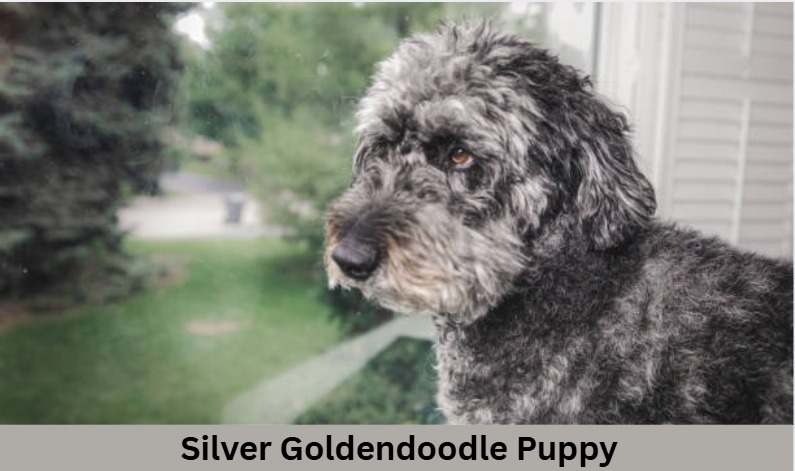
What Is a Silver Goldendoodle?
A Silver Goldendoodle is a fluffy, friendly mixed-breed dog with a stunning silver-gray coat. These adorable pups are a cross between a Golden Retriever and a Poodle, which means they get the best traits from both parents—smart, loving, and low-shedding!
Silver Goldendoodle: Quick Reference Guide
| Category | Key Takeaways |
|---|---|
| What They Are | Golden Retriever + Poodle mix with a rare silver-gray coat. Hypoallergenic, smart, and family-friendly. |
| Color Genetics | Born dark (black/brown), fade to silver by age 2 due to Poodle’s “dilution gene.” |
| Coat Types | Curly (most hypoallergenic), Wavy (classic look), Straight (easiest to brush). |
| Size Varieties | Mini (15–35 lbs), Standard (45–90 lbs). Minis cost more due to high demand. |
| Temperament | Friendly, playful, and highly trainable. Great with kids/pets. Color doesn’t affect personality. |
| Grooming Needs | Brush 3x/week, trim every 6–8 weeks. Use color-safe shampoo to maintain silver shine. |
| Health & Lifespan | 10–15 years. Prone to hip dysplasia, allergies, and ear infections. Choose health-tested parents. |
| Price Range | 2,000–2,000–4,000 (Standard), 2,500–2,500–4,500+ (Mini). Higher for rare blues/phantoms. |
| Buying Tips | Avoid breeders under $1,800. Ask for: health tests, adult photos, and a lifetime guarantee. |
| Best For | Active families, first-time owners, or anyone who can commit to regular grooming. |
Pro Tip: Their silver coat is stunning but requires upkeep—focus on health/temperament first!
Meet the Parents: Golden Retriever + Poodle
- Golden Retriever → Super sweet, loyal, and great with kids.
- Poodle → Super smart, hypoallergenic, and curly-coated.
Mix them together, and you get a Goldendoodle—a perfect family dog! Now, when a Goldendoodle has a silver coat, we call it a Silver Goldendoodle.
How Does the Silver Color Fit In?
Goldendoodles come in many colors—gold, cream, red, chocolate, and even silver! The silver shade happens because of a special dilution gene that lightens their fur. Some silver Doodles are born dark and slowly turn lighter as they grow.
Read more about: Goldendoodle colors
Is “Silver” an Official Goldendoodle Color?
Yes! While not as common as gold or cream, silver is a real and recognized color in Goldendoodles. Some breeders specialize in silver coats (like Silver Creek Goldendoodles). Just remember—no two silver Doodles look exactly alike! Some are light silver, some dark gray, and others have cool patterns like phantom (black markings) or parti (white patches).
Fun Fact: Their fur can look different in sunlight vs. shade—like a shiny gray treasure! ✨
How Do Silver Goldendoodles Get Their Color?
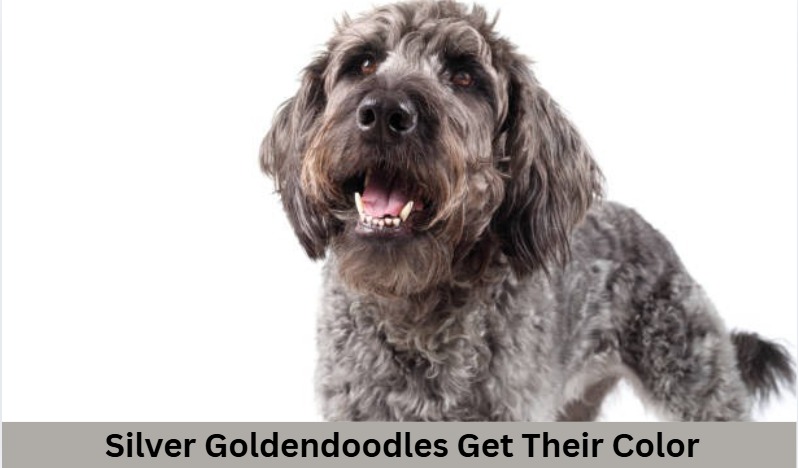
Silver Goldendoodles have one of the most fascinating coat colors—but how do they get that gorgeous silvery shade? It all comes down to special genes passed down from their Poodle parents!
Poodle Genetics & The “Fading” Gene
The secret behind a silver coat is something called the “fading” or “dilution” gene. This gene lightens a dog’s original coat color over time. Here’s how it works:
- Poodles (especially silver Poodles) carry this gene.
- When mixed with a Golden Retriever, some puppies inherit it—resulting in a silver, gray, or “blue” coat instead of gold.
Read about: Goldendoodle Generations
Do Silver Goldendoodles Start Out Black?
Yes! Most silver Goldendoodles are born black or dark brown—you wouldn’t even guess they’ll turn silver! But as they grow (usually between 6 months to 2 years), their coat slowly lightens to a shimmering silver or gray.
Timeline of Color Change
- Newborn: Black or dark brown
- 2-4 months: Starts getting lighter (milk coffee color)
- 6-12 months: Clearly fading to silver/gray
- 1-2 years: Final shade appears (can be light silver, steel gray, or even a bluish tint)
Silver vs. Gray vs. Blue Goldendoodles—What’s the Difference?
| Color Type | Appearance | Genetic Basis | Rarity | Price Impact | Coat Changes Over Time | Best With Coat Type |
|---|---|---|---|---|---|---|
| Silver | Bright, metallic sheen (like sterling silver) | Dilution gene on black base coat | Uncommon | $800−$1,200 | Often born black → fades by 2 years | Curly or wavy coats show shine best |
| Gray (Charcoal) | Muted, solid stormcloud gray | Dominant gray gene | Moderately rare | $500−$800 | Minimal fading after 1 year | All coat types (shows depth well) |
| Blue | Cool-toned with subtle slate blue undertones | Rare recessive “blue dilution” gene | Very rare | $1,500−$2,000 | May develop more blue tint with age | Tight curls enhance color depth |
Fun Fact: Some silver Doodles keep a few dark patches, especially around the ears—this is called a “phantom” pattern and looks extra cool!
Do Silver Goldendoodles Change Color Over Time?
Yes! Silver Goldendoodles are like magical color-changing pups—they often look completely different as adults compared to when they were babies. Let’s break down how this amazing transformation happens.
Puppy to Adult Color Transition
Most silver Goldendoodles are born with dark coats—usually black or dark brown. But don’t be fooled! Their true silver color slowly appears as they grow. Here’s what to expect:
- Newborn: Jet black or deep chocolate
- 2-4 months: Starts looking “dusty” (lighter around the face & paws)
- 6-12 months: Clearly fading to silver or gray
- 1-2 years: Final shade settles in (can be light silver, steel gray, or even bluish)
When Does the Fading Happen?
The color change usually starts around 8-12 weeks old, but the biggest shift happens between 6 months to 1.5 years. Some pups keep changing slightly until they’re 2 years old.
Before & After Examples
- Before (Puppy): A fluffy black ball of fur with maybe a few lighter hairs on the paws.
- After (Adult): A stunning silver-gray dog with a soft, shiny coat!
What Affects How Much They Fade?
Not all silver Goldendoodles fade the same way. Here’s what plays a role:
- Genetics – If both parents carry the fading gene, the puppy will likely turn much lighter.
- Diet – Healthy food with omega fatty acids can keep their coat shiny and help the color develop nicely.
- Sun Exposure – Just like human hair, sunlight can lighten their fur a little over time.
- Grooming – Regular brushing helps remove old, dark puppy fur so the new silver hairs show better.
Fun Fact: Some silver Doodles keep a few darker “ghost” markings on their ears or back—this is called a “phantom” pattern and makes them extra unique!
Silver Goldendoodle Coat Types
Silver Goldendoodles come in three main coat types—curly, wavy, and straight. Each one gives them a unique look and feel, and some even make their silver color stand out more! Let’s explore the differences.
1. Curly Coats (Like a Poodle!)
- Looks like: Tight, springy curls (think of a plush teddy bear!)
- Best for: Allergy sufferers (sheds the least)
- Silver color effect: The curls reflect light beautifully, making the silver shade look extra shiny and vibrant.
2. Wavy Coats (The “Classic” Goldendoodle Look)
- Looks like: Loose, beachy waves (soft and fluffy)
- Best for: Families who want a mix of curly and low-maintenance
- Silver color effect: The waves give the coat dimension, so the silver can look lighter or darker depending on how the fur lays.
3. Straight Coats (More Like a Golden Retriever)
- Looks like: Smooth, silky fur (less frizz, more flow)
- Best for: Easy brushing (less tangling)
- Silver color effect: The straight fur shows off the true, solid color best—no curls or waves hiding it!
Which Coat Type Shows Silver Best?
- Curly coats make silver look bright and shiny (great for that “sparkly” effect).
- Wavy coats give a natural, blended silver (like soft gray clouds).
- Straight coats show the truest, most even silver color (no twists or shadows).
Coat Texture & Thickness
- Thick coats: More fluffy and plush (great for colder weather).
- Thin coats: Lighter and airier (good for warmer climates).
- Softness: Most silver Doodles have super-soft fur—like petting a bunny!
Pro Tip: No matter the coat type, regular brushing keeps their silver fur looking sleek and tangle-free!
Mini Silver Goldendoodle Overview
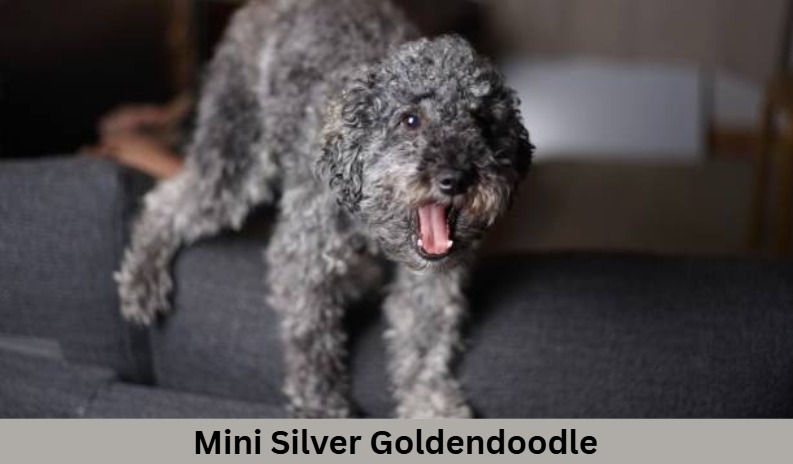
What Is a Mini Silver Goldendoodle?
A Mini Silver Goldendoodle is a smaller, more compact version of the regular Silver Goldendoodle. These adorable pups have the same beautiful silver coat but in a petite package—perfect for people who want all the love and fun of a Goldendoodle in a smaller size!
Size, Height & Weight
- Height: 13–20 inches at the shoulder (about the size of a small to medium dog)
- Weight: 15–35 pounds (light enough to pick up easily!)
- Lifespan: 10–15 years (just like standard Goldendoodles)
Differences From Standard Silver Goldendoodles
- Size: Mini = apartment-friendly; Standard = bigger (45–90 lbs).
- Energy Level: Minis are lively but don’t need as much space to run.
- Cost: Mini versions often cost a bit more because they’re in high demand.
- Coat: Same silver shades, but their small size makes them look extra cute and teddy bear-like!
Why Are Mini Silver Goldendoodles So Popular?
- Perfect for small homes (apartments, condos, city living).
- Easier to travel with (fits better in cars, planes, and small spaces).
- Just as friendly and smart—just in a smaller body!
Fun Fact: Their tiny size makes them look like forever puppies, even when fully grown!
Are Silver Goldendoodles Rare?
Silver Goldendoodles are less common than classic gold or cream Goldendoodles, but they’re not extremely rare. Here’s what makes them special—and sometimes harder to find!
How Common Is the Silver Color?
- Not as common as golden or red coats, but not impossible to find.
- More breeders are now offering silver due to growing popularity.
- You’ll see them more often in Poodle-heavy mixes (like F1B Goldendoodles).
Breeding Difficulty
- Silver requires specific genes (the “dilution” gene from Poodles).
- Not every Goldendoodle litter will have silver puppies—it depends on the parents.
- Reputable breeders (like Silver Creek Goldendoodles) specialize in this color.
Are They More Expensive?
- Yes, usually! Silver Goldendoodles often cost 500–500–1,000 more than standard colors.
- Reasons:
- Higher demand for the unique color.
- Fewer breeders produce true silvers (not just grayish coats).
Is the Silver Coat in High Demand?
- Absolutely! People love their stunning, shiny coats.
- Silver Doodles stand out in photos and get lots of compliments.
- Their “fading” gene makes them fun to watch as they change from dark puppies to silvery adults.
Final Thought: While not super rare, silver Goldendoodles are special enough to be in demand—and worth the wait if you’re set on this gorgeous color!
Silver Goldendoodle Temperament & Personality
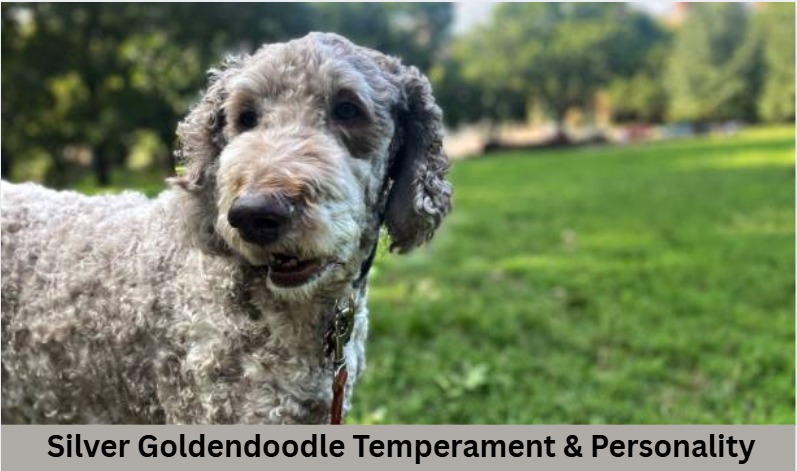
Silver Goldendoodles aren’t just pretty—they have big, lovable personalities to match their stunning coats! Let’s break down what makes them such fantastic companions.
General Goldendoodle Personality
These dogs are known for being:
✅ Friendly & social – They love people and make instant friends.
✅ Smart & eager to please – Easy to train (thanks to their Poodle genes!).
✅ Playful but gentle – Perfect for both active play and couch cuddles.
✅ Low aggression – Rarely barky or nippy when properly socialized.
Does Coat Color Affect Temperament?
Nope! Silver, gold, or red—all Goldendoodles share the same wonderful traits. Color is just fur-deep; their behavior depends on:
- Genetics (Golden Retriever + Poodle mix)
- Training & socialization (early exposure to people/pets helps!)
- Individual personality (some are calm, some are silly clowns!)
Family-Friendly Traits
Silver Goldendoodles are ideal family dogs because they:
- Adore kids – Patient and gentle with little ones.
- Get along with other pets – Usually friendly with cats and dogs (if introduced properly).
- Adapt easily – Happy in apartments or big homes, as long as they get love and exercise!
Behavior With Kids & Other Pets
- With kids: Naturally gentle and tolerant. Their soft mouths (a Retriever trait) mean they’re less likely to nip.
- With other dogs: Typically playful and social, especially if raised together.
- With cats: Can coexist peacefully if introduced slowly (though some may chase at first!).
Pro Tip: Start training and socialization early to ensure your silver pup grows into a well-mannered adult!
Grooming a Silver Goldendoodle
Maintaining the stunning coat of a Silver Goldendoodle requires regular care to keep it healthy and vibrant. Their unique silver color can fade or develop dullness without proper grooming, so establishing a consistent routine is essential. Start with daily or every-other-day brushing using a slicker brush to prevent mats and tangles, especially in curly or wavy coats. Follow up with a metal comb to reach deeper layers and ensure no knots are left behind.
The best grooming tools for a Silver Goldendoodle include a high-quality slicker brush, a stainless steel comb, and grooming scissors for trimming around the face, paws, and tail. A detangling spray can also help smooth out stubborn knots without damaging the fur. For baths, use a gentle, color-enhancing dog shampoo designed for light or silver coats to maintain their shine and prevent discoloration.
Brushing should be done at least three times a week, but daily brushing is ideal for preventing mats. Professional trimming every 6-8 weeks keeps their coat manageable and tidy, especially around high-friction areas like the ears and legs. Pay extra attention to their paws and sanitary areas to avoid dirt buildup.
To keep their silver color vibrant, avoid excessive sun exposure, which can cause fading. Rinse their coat thoroughly after swimming in chlorinated or saltwater, as these can dry out their fur and alter its hue. A diet rich in omega-3 fatty acids supports coat health, making their silver shade appear glossier. Regular grooming not only maintains their stunning look but also keeps their skin healthy and free from irritation.
Consistency is key—stick to a grooming schedule, and your Silver Goldendoodle’s coat will stay soft, shiny, and beautifully silver for years to come.
Health & Lifespan of Silver Goldendoodles
Silver Goldendoodles are generally healthy dogs, but like all breeds, they can be prone to certain health conditions. Their lifespan typically ranges between 10 to 15 years, depending on genetics, diet, and overall care. While their silver coat color doesn’t directly affect their health, responsible breeding and proper care play a big role in keeping them happy and thriving.
Some common health concerns in Silver Goldendoodles include hip dysplasia, ear infections (due to their floppy ears), allergies, and eye conditions like progressive retinal atrophy (PRA). Because they inherit traits from both Poodles and Golden Retrievers, they may also be susceptible to conditions like Addison’s disease or heart issues. Reputable breeders perform health testing on parent dogs to minimize these risks, so always ask for documentation before bringing a puppy home.
To keep your Silver Goldendoodle in top shape, regular vet check-ups are a must. Schedule annual exams, stay up-to-date on vaccinations, and maintain a consistent flea, tick, and heartworm prevention routine. Their diet should include high-quality protein, healthy fats (like omega-3s for coat health), and joint-supporting supplements if recommended by your vet.
Since their coat can be prone to skin sensitivities, use gentle, hypoallergenic grooming products to avoid irritation. Keep their ears clean and dry to prevent infections, and brush their teeth regularly to avoid dental disease. Moderate exercise—like daily walks and playtime—helps maintain a healthy weight and prevents joint problems.
With proper care, your Silver Goldendoodle can enjoy a long, active, and vibrant life. Their stunning silver coat will stay beautiful as long as their overall health is prioritized, making them not just a pretty companion but a resilient and loving one too.
Silver Goldendoodle Full Grown: What to Expect
When your Silver Goldendoodle reaches adulthood, you’ll notice their appearance stabilizes into the stunning, silvery companion you envisioned. These dogs typically reach their full size between 12-18 months, with their coat color settling into its permanent shade around 2 years old.
Adult Appearance
A mature Silver Goldendoodle sports a luxurious coat that ranges from light platinum to deep charcoal silver, often with beautiful variations in tone. Their facial features become more defined, with expressive eyes that contrast beautifully against their silvery fur. The adult coat is typically thicker and more uniform than the puppy coat, with the signature Doodle curls or waves fully developed.
Weight and Height
Standard Silver Goldendoodles weigh 45-90 pounds and stand 20-26 inches tall at the shoulder. Miniatures reach 15-35 pounds with a height of 13-20 inches. Their sturdy, athletic build reflects their Golden Retriever heritage, while their elegant posture shows off their Poodle lineage.
Mature Coat and Color
The puppy’s initial dark coat completely transforms to its adult silver shade, which can appear:
- Cool-toned steel silver
- Warm pewter gray
- Rare blue-ish silver in some bloodlines
The coat texture also changes – puppy fluff gives way to either tight Poodle-like curls (most common), loose waves, or occasionally a straighter Retriever-style coat.
Changes From Puppy Stage
- Color transition complete – no more dramatic fading
- Coat texture thickens – becomes more weather-resistant
- Facial furnishings grow in – fuller beard and eyebrows
- Body proportions balance out – lanky adolescent look disappears
Pro Tip: Adult coats require more frequent grooming (every 6-8 weeks) as the denser fur mats more easily. Their stunning silver color stays vibrant with proper care, though some may develop charming “silver tipping” on the ears as they age.
These elegant adults retain their puppy-like enthusiasm while gaining the calm confidence of maturity, making them perfect companions for active families or singles alike. Their hypoallergenic qualities also become more pronounced in adulthood as their coat fully develops.
Silver Goldendoodle Price & Availability
Average Price Range:
Expect to invest $2,000–$4,000 for a Silver Goldendoodle from a quality breeder, with top-tier bloodlines reaching $5,000+.
Mini vs Standard Silver Goldendoodle Price Comparison
| Size Category | Average Price Range | Key Pricing Factors |
|---|---|---|
| Miniature | $2,500−$4,500 | Higher demand for compact size, specialized breeding with toy/mini Poodles, ideal for urban living |
| Standard | $2,000−$3,500 | More common size, easier breeding process, suitable for families with more space |
Why Miniatures Cost More:
- Requires breeding with smaller-generation Poodles (increasing complexity)
- Higher demand from apartment/condo owners
- Fewer silver mini doodles available per litter
- Often come from multi-generational breeding programs
Key Pricing Factors
- Generation (F1B often priciest for hypoallergenic traits)
- Breeder Reputation (AKC-registered parents cost more)
- Coat Quality (Consistent silver with no brindling commands top dollar)
- Geographic Location (Urban coastal areas see 20-30% higher prices)
- Training Included (Puppies with basic obedience training add $500+)
Availability Notes
Expect waiting lists of 6-12 months for quality silver puppies. Beware of “discount” silver doodles under $1,800 – these often result from poor breeding practices and may not maintain their color or health. Reputable breeders like Silver Creek Goldendoodles typically have application processes and deposits to secure a puppy.
Pro Tip: The premium price reflects not just the coat color, but typically includes health guarantees, early socialization, and superior genetic testing – all crucial for this relatively new color variation in the Goldendoodle world.
Real Owner Experience: Meet Luna, the Silver Goldendoodle
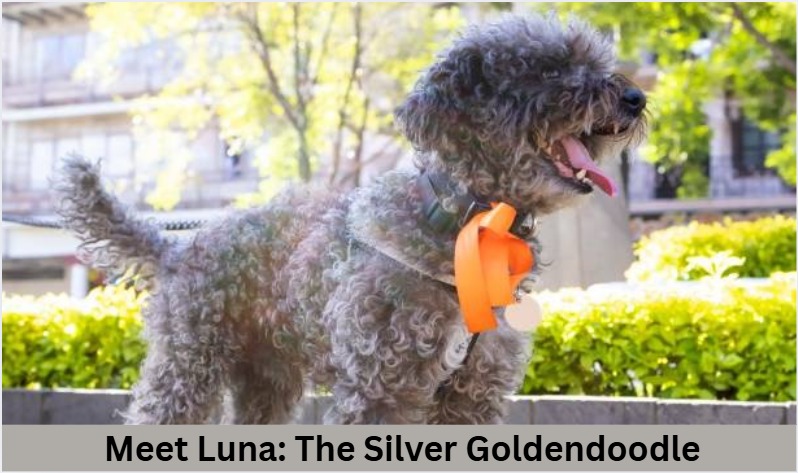
When Sarah brought home her Silver Goldendoodle puppy, Luna, she was prepared for the grooming demands but still marveled at her transformation. “She was born nearly black, but by her first birthday, her coat had lightened to this gorgeous silvery taupe—like moonlight on fur,” Sarah says. While Luna’s stunning coat draws constant compliments at the park, Sarah emphasizes it’s her personality that truly shines. “She’s my shadow—always leaning against my legs or offering a paw. The intelligence from her Poodle side means she learned ‘turn off the lights’ in three tries, but she has the Golden Retriever’s goofy charm too.”
The upkeep is real—weekly brushing sessions and bi-monthly grooming appointments keep Luna’s coat mat-free. “I budget $100/month for grooming,” Sarah admits, “but seeing her prance with that shiny silver fur makes it worth it.” Her one surprise? “I thought the silver color would be high-maintenance, but it actually hides dirt better than my friend’s white Goldendoodle!”
For those considering the breed, Sarah advises: “Don’t fixate on getting the perfect silver shade—Luna’s color changed dramatically until she was two. Focus instead on finding a breeder who prioritizes health and temperament. Our girl did develop a minor skin allergy (common in Poodle mixes), but with proper care, it’s easily managed. Three years in, she’s my constant adventure buddy, whether hiking or just curling up with a book. That silver fur is just the glitter on an already perfect companion.”
Luna’s Stats:
- Age: 3 years
- Generation: F1B (75% Poodle)
- Coat Type: Tight curls (shows silver tones best)
- Favorite Trick: “Bring me my slippers”
- Grooming Routine: Professional groom every 6 weeks + weekly at-home brushing
This real-life account shows how the breed’s beauty and brains play out in everyday life—with both the joys and responsibilities owners can expect.
Silver Goldendoodle Puppies for Sale: What to Look For
Choosing a Responsible Breeder
A reputable breeder is key to ensuring a healthy, well-socialized Silver Goldendoodle. Look for:
✅ Health Testing – Parents should be screened for hip dysplasia, eye conditions (PRA), and heart issues. Ask for OFA or PennHIP certifications.
✅ Transparent Lineage – The breeder should provide pedigree papers showing at least 3 generations of silver-coated ancestry.
✅ Clean, Loving Environment – Puppies should be raised indoors with proper socialization (exposed to sounds, people, and handling).
✅ Lifetime Support – Ethical breeders offer guidance and often take dogs back if rehoming is needed.
Top Questions to Ask Before Buying
- “Can I meet the puppy’s parents?” (Assess temperament & coat quality)
- “What health guarantees do you provide?” (Look for at least a 2-year genetic health warranty)
- “How do you socialize the puppies?” (Early ENS training and exposure to stimuli is ideal)
- “Can I see previous litters’ adult photos?” (Ensures the silver coat stays true with age)
Red Flags to Avoid
🚩 Too Cheap – Prices under $1,800 often mean poor breeding practices.
🚩 No Health Testing – Avoid breeders who say, “My dogs are healthy, no tests needed.”
🚩 Puppies Always Available – Reputable breeders have waitlists (6-12 months is normal).
🚩 Pressure to Buy – A good breeder interviews you as much as you interview them.
Adoption vs. Breeder Route
- Breeder Benefits: Predictable size, coat, and temperament; health guarantees.
- Adoption Option: Check Doodle rescues (occasionally silver adults need homes).
Final Tip: If buying, choose breeders like Silver Creek Goldendoodles with proven silver lineage. If adopting, be patient—true silver rescues are rare but rewarding!
Final Thoughts: Is a Silver Goldendoodle Right for You?
A Silver Goldendoodle makes a wonderful pet for the right owner, combining good looks with a loving personality. These dogs thrive in active households where they’ll receive plenty of attention, exercise, and proper grooming. While their striking silver coats command higher prices (typically $2,000−$4,000) and require regular maintenance, you’re paying for more than just color – you’re investing in the breed’s intelligence, hypoallergenic qualities, and friendly nature.
They’re ideal for families, singles, and first-time dog owners who don’t mind the grooming commitment. The silver coloration does make them stand out, but remember that beneath that gorgeous coat beats the heart of a typical Goldendoodle – playful, affectionate, and eager to please. If you can handle weekly brushing, professional grooming every 6-8 weeks, and the initial investment, a Silver Goldendoodle will reward you with years of companionship and countless compliments on their unique appearance. Just be sure to choose a reputable breeder who health tests their dogs and can show you adult examples of their silver lines, as puppy coats often change significantly as they mature.
For those interested in learning about other Goldendoodle sizes, you can check out our detailed articles on Standard Goldendoodle, Teacup mini Goldendoodle, Mini Goldendoodle, micro mini Goldendoodle, Medium Goldendoodle, Petite Goldendoodle and other related breeds. Each color has its own unique qualities, and understanding the differences can help you choose the best fit for your lifestyle.
Frequently Asked Questions (FAQs)
Q: What causes a Goldendoodle to have a silver coat?
The silver coat comes from the fading gene inherited from the Poodle parent. Puppies are usually born black and gradually lighten.
Q: Do all black Goldendoodle puppies fade to silver?
No, only those with the specific silver-fading gene will change color over time.
Q: At what age does the silver color typically emerge?
Silver starts showing between 6 to 10 months and completes by 2 years of age.
Q: Is the silver coat color linked to specific generations (e.g., F1, F1b)?
Not directly, but it’s more common in generations with higher Poodle genetics like F1B or F2B.
Q: What are the different coat types in Silver Goldendoodles?
They can have curly, wavy, or straight coats, depending on genetics.
Q: How does the silver color affect grooming needs?
The color doesn’t affect grooming, but lighter shades may show dirt more easily.
Q: Are silver-coated Goldendoodles more prone to matting?
No, matting depends on coat type, not coat color.
Q: How often should a Silver Goldendoodle be groomed?
Brush 3–4 times a week and get professional grooming every 6–8 weeks.
Q: Does coat color influence the temperament of a Goldendoodle?
No, temperament is based on genetics and upbringing, not coat color.
Q: Are Silver Goldendoodles suitable for families with children?
Yes, they are gentle, playful, and great with kids.
Q: How do they interact with other pets?
They are social and usually get along well with other pets.
Q: Are they easy to train?
Yes, they’re intelligent and eager to please, making training easy.
Q: Can Silver Goldendoodles adapt to apartment living?
Yes, if exercised daily and mentally stimulated, they do well in apartments.
Q: Are there specific health concerns associated with the silver coat?
No health issues are linked specifically to the silver color.
Q: What is the average lifespan of a Silver Goldendoodle?
They typically live 10 to 15 years with good care.
Q: Are Silver Goldendoodles more expensive than other colors?
Yes, their rarity often makes them slightly more expensive.
Q: How can I identify a reputable breeder for Silver Goldendoodles?
Look for health testing, reviews, and transparency on genetics and parent dogs.





Leave a Reply